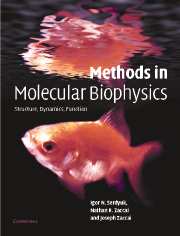Book contents
- Frontmatter
- Contents
- Foreword by D. M. Engelman
- Foreword by Pierre Joliot
- Preface
- Introduction: Molecular biophysics at the beginning of the twenty-first century: from ensemble measurements to single-molecule detection
- Part A Biological macromolecules and physical tools
- Chapter A1 Macromolecules in their environment
- Chapter A2 Macromolecules as physical particles
- Chapter A3 Understanding macromolecular structures
- Part B Mass spectrometry
- Part C Thermodynamics
- Part D Hydrodynamics
- Part E Optical spectroscopy
- Part F Optical microscopy
- Part G X-ray and neutron diffraction
- Part H Electron diffraction
- Part I Molecular dynamics
- Part J Nuclear magnetic resonance
- References
- Index of eminent scientists
- Subject Index
- References
Chapter A1 - Macromolecules in their environment
from Part A - Biological macromolecules and physical tools
Published online by Cambridge University Press: 05 November 2012
- Frontmatter
- Contents
- Foreword by D. M. Engelman
- Foreword by Pierre Joliot
- Preface
- Introduction: Molecular biophysics at the beginning of the twenty-first century: from ensemble measurements to single-molecule detection
- Part A Biological macromolecules and physical tools
- Chapter A1 Macromolecules in their environment
- Chapter A2 Macromolecules as physical particles
- Chapter A3 Understanding macromolecular structures
- Part B Mass spectrometry
- Part C Thermodynamics
- Part D Hydrodynamics
- Part E Optical spectroscopy
- Part F Optical microscopy
- Part G X-ray and neutron diffraction
- Part H Electron diffraction
- Part I Molecular dynamics
- Part J Nuclear magnetic resonance
- References
- Index of eminent scientists
- Subject Index
- References
Summary
Historical review
The discovery of biological macromolecules is tightly interwoven with the history of physical chemistry, which formally emerged as a discipline in 1887, when the journal founded by Jacobus Van't Hoff and Wilhelm Ostwald, Zeitschrift für Physikalische Chemie, was first published. Interestingly, the first papers were concerned with reactions in solution, because biological processes essentially take place in the aqueous environment inside living cells.
The nineteenth century discoveries of solution properties that led to our knowledge about biological macromolecules are described briefly in the Introduction. We must also mention the Grenoble chemist François-Marie Raoult (1886), who formulated the freezing-point depression law that made it possible to determine the molecular weight of dissolved substances, and Hans Hofmeister (1895), a medical doctor and physiologist, who was interested in the diuretic and laxative effects of salts, and classified them according to how they modified the solubility of protein in aqueous solutions. The Hofmeister series was later established as a ranking order of the ‘salting-out’, or precipitating, efficiency of ions. Gilbert Newton Lewis introduced the concepts of activity in 1908, and of ionic strength, with Merle Randall in 1921. In 1911, Frederick George Donnan published a paper on the membrane potential developed during dialysis of a non-permeating electrolyte. Peter Debye and Erich Hückel (1923) proposed a theory for electrolyte solutions. In recent decades, modern methods, such as dynamic light scattering and small-angle neutron scattering, developed for the characterisation of polymers, and especially polyelectrolytes, have contributed significantly to our current understanding of biological macromolecules in solution.
- Type
- Chapter
- Information
- Methods in Molecular BiophysicsStructure, Dynamics, Function, pp. 21 - 37Publisher: Cambridge University PressPrint publication year: 2007



